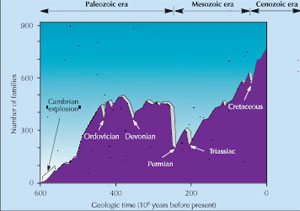Macroevolution: Major Evolutionary Events
Macroevolution:
Major Evolutionary
Events
Macroevolution describes large-scale
events in organic evolution. Speciation
links macroevolution and microevolution.
Major trends in the fossil record
described earlier (see Figures 6-11 and
6-12) are clearly within the realm of
macroevolution. Patterns and processes
of macroevolutionary change emerge
from those of microevolution, but they
acquire some degree of autonomy in
doing so. The emergence of new adaptations
and species, and the varying
rates of speciation and extinction
observed in the fossil record go
beyond the fluctuations of allelic frequencies
within populations.
Stephen Jay Gould recognizes three different “tiers” of time at which we observe distinct evolutionary processes. The first tier constitutes the timescale of population genetic processes, from tens to thousands of years. The second tier covers millions of years, the scale on which rates of speciation and extinction can be measured and compared among different groups of organisms. The third tier covers tens to hundreds of millions of years, and is marked by occurrence of periodic mass extinctions. In the fossil record of marine organisms, mass extinctions recur at intervals of approximately 26 million years. Five of these mass extinctions have been particularly disastrous (Figure 6-32). The study of long-term changes in animal diversity focuses on the third-tier timescale (see Figures 6-12 and 6-32).
 |
| Figure 6-32 Changes in numbers of families of marine animals through time from the Cambrian period to the present. Sharp drops represent five major extinctions of skeletonized marine animals. Note that despite the extinctions, the overall number of marine families has increased to the present. |
Stephen Jay Gould recognizes three different “tiers” of time at which we observe distinct evolutionary processes. The first tier constitutes the timescale of population genetic processes, from tens to thousands of years. The second tier covers millions of years, the scale on which rates of speciation and extinction can be measured and compared among different groups of organisms. The third tier covers tens to hundreds of millions of years, and is marked by occurrence of periodic mass extinctions. In the fossil record of marine organisms, mass extinctions recur at intervals of approximately 26 million years. Five of these mass extinctions have been particularly disastrous (Figure 6-32). The study of long-term changes in animal diversity focuses on the third-tier timescale (see Figures 6-12 and 6-32).




